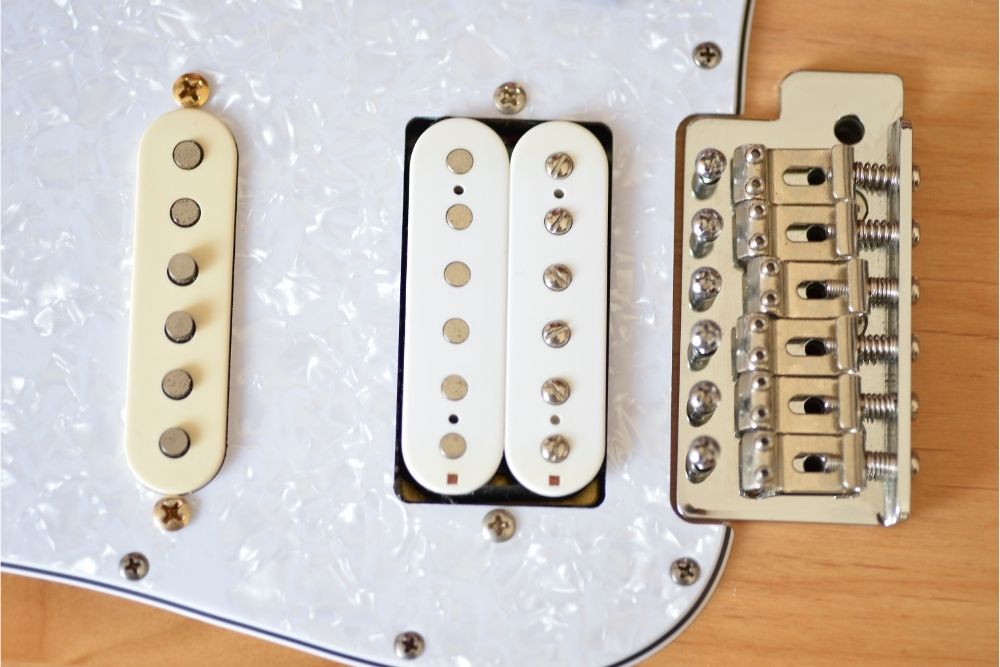Have you ever wondered what makes the electric guitar so, well… electric? Here’s a hint: It’s not the power of rock and roll, nor is it a dinosaurian Marshall stack (although that certainly helps). It’s – drumroll please – magnets!
That’s right, folks, the magic is in the magnets and these magnets can be found in your pickups, those short metal or plastic strips on the body of your axe, resting beneath the strings.
It’s the magnets that sense the oscillation of the strings when you strum a big fat A chord AC-DC style or rip a classical run à la Yngwie Malmsteen.

The pickups then send the signal through some internal wiring, through your ¼” jack, through your amplifier, and, finally, the sound reaches your ears.
Yep, pickups are powerful things, and you only ever really need one of them to start making some noise, yet most guitars arrive with two or three of them….
Why is this, and what’s the difference between a bridge and neck pickup? Well, stick with me, and all will be revealed!
The Quick Answer
The key difference between the bridge and neck pickup is the tone they produce. The bridge pickup offers up a much brighter, more piercing sound often used for punky power chords, monster riffs, and shreddy, Marty Friedman-esque solos.
The neck pickup, on the other hand, is thick, warm, and dark-sounding, making it the perfect tone for robust rhythms, and creamy guitar leads — think Slash’s solo in November Rain.
Now, bear in mind that this is just the quick answer, and pickups are a little more complex than I’m making them out to be. These magnetized wonders fall into two main sub-categories: single coils and humbuckers.
A neck humbucker will sound completely different from a single-coil neck pickup, and a humbucker bridge pickup will sound completely different to a single-coil bridge pickup,
but that’s neither here nor there. Today, we’re focusing on more general differences between all neck pickups and all bridge pickups.
The Sound of Bridge Pickups
As mentioned earlier, the bridge pickup has a sharper sound, and it’s capable of cutting through the cacophony of a band. It favors strong treble frequencies rather than powerful bass vibrations, and it’s perfect for super distorted or fuzzed-out playing.
Most thrash metal, for instance, is played using the bridge pickup.
James Hetfield’s (Metallica) crushing power chords and riffs in Master of Puppets, Dave Mustaine’s (Megadeth) noodling licks in Tornado of Souls, and Kerry King’s (Slayer) pinch harmonic-laden leads and guttural chugs are all played on the bridge pickup.
But the bridge pickup is so much more than a metal mainstay. Dial back the distortion, and you’ll enjoy that super spanky sound heard so often in funk, bluegrass, and country music.
If you’re looking for some serious twang, the bridge is where you’ll find it!
The reason the bridge pickup sounds so different comes down to its placement on the guitar. The magnets are reading the signal from the strings just as they leave the saddle where there’s a lot more tension, which is what creates a punchy, bright tone.
To compensate for the lack of vibrations in this area of the guitar, bridge pickups are usually slightly “hotter” than their neck counterparts, and their superb sonic character makes them a shoo-in for certain musical applications.
Cutting Through the Mix
The mix is just the combination of sounds from multiple sources and how they work together. Some sounds blend into the mix, while others stand out on top of it. You think of it kind of like a stage production.
The extras are towards the back, blending into the set, while the lead is in the foreground, closer to the audience than anyone else.
In this analogy, the bridge pickup is very much the star of the show, but instead of being closer to an audience, it’s closer to the ear.
With your tone pot dimed, your bridge pickup provides ultimate articulation. You play a chord and hear every last note ring out, which is why it’s a good choice for distorted music — it helps to retain a certain amount of sonic definition.
If your bridge pickup is a little too sharp to your ears, try turning your tone pot down a smidge to round the harsh edges.
Riffage and Shred
It’s not that the bridge pickup is used exclusively for distorted guitar licks. Tom Morello of Rage Against the Machine often uses the thicker neck pickup to really lock in with the bass and double the power of a monster riff.
However, if the bass is doing one thing, and you’re doing another, it’s pretty common practice to use the tighter-sounding bridge pickup.
Furthermore, when it comes to super-fast, 80s, Eddie Van Halen style shredding, the articulation of the bridge pickup ensures all the notes ring out with clarity.
The Sound Of Neck Pickups

Whereas the bridge pickup has a metallic resonance, the neck pickup has a richer, more oaken sonic profile. This is because it’s reading signals closer to the middle of the strings, where oscillation width is at its peak.
These robust, warm tones are perfect for jazz rhythms, buttery smooth blues solos, and soaring rock leads, although they can get a little “muddy” in the mix, meaning they’re not too articulate to the ear at times.
Remember the stage show analogy I gave earlier? Well, in that context, the neck pickup would be a supporting role rather than the lead. They don’t blend completely into the set, but they don’t draw a lot of focus either.
The neck pickup has a distinctive mellow quality. If it was a shape it would have lots of smooth, curving edges, whereas the bridge pick up would have lots of straight edges and sharp corners.
If tones were physical actions, the sound of the neck pickup would be a soft, open-palm push, whereas the bridge pickup would be a sharp poke.
On clean settings, you might say that the neck pickup sounds tender, and embracing, but when you crank the gain, it’s a different story.
Layer some fuzz on your neck pickup to form a brutal sonic Goliath, stomping around all over the place, crushing houses and cars as it goes. It’s not such a clear sound, but if you’re on the hunt for power and pure, unadulterated thump, that’s where you’ll find it!
Famous Examples of Neck Pickups in Music
Is there any riff more iconic, more identifiable than the intro to Sweet Child of Mine by Guns N’ Roses? I don’t think so.
That sound is seared into our collective brains forever and for eternity, and it’s a shining example of how the neck pickup is used in popular music.
In fact, I once saw Slash in an interview claiming that he also turned his tone pot almost all the way down to achieve that devilishly thick sound.
Slash also uses the neck pickup for the first half of the solo, but if you listen closely, as he brings his wah pedal into the mix, you’ll notice his tone thins out a great deal.
This is because he’s flicked his pickup selector to the bridge position in order to bring some clarity to his tone so the wah modulation doesn’t completely overpower the articulation of the notes.
If you’re a fan of Queen, your ears will be well acquainted with the sound of the neck pickup, whether you realize it or not.
Brian May is infamous for his fat lead tones, although the unique controls of his custom “Red Special” guitar do enable him to play with tone in slightly different ways than a standard 6 string.
Pink Floyd is another one to watch. Listen to the first solo in Comfortably Numb — that’s some quintessential neck pickup action!
Finding Your Sound
You can use the examples I’ve given here today to inform your guitar playing and pickup choice, but the important thing to remember is that there are absolutely no rules. It all comes down to what sounds good to you and how tone serves a song.
You don’t have to use your bridge pickup for power chords. Feel free to buy a fuzz, and go full Neutral Milk Hotel with some uber-thick, pummeling tones. Conversely, you don’t have to use your neck pickup for a soaring blues solo.
Shake things up a bit with your bridge pickup, or perhaps even a combination of both.
Musicians such as yourself deciding to do something in a slightly different way is what drives music forward, so never feel you have to do something because that’s what Jimmy Page did, or that something must be done a certain way because Zakk Wylde mentioned it in a tutorial online.
Cutting your own tonal path with your music is essential.
Every time you come up with or learn a riff or solo, experiment with different pickups and see how it changes the timbre of the passage. Sound is subjective, so there is no right answer. You’re the boss of your tone, and what you say goes!
Selector Switches: 3-Way vs 5-Way
The selector switch on a guitar is that little toggle that lets you choose which pickup is active, and they normally follow one of two formats: 3-way selection, or 5-way selection.
Guitars with 2 pickups, such as the Gibson Les Paul, SG, and Fender Telecaster usually have a 3-way selector switch, meaning you can choose between three core tones.
Position one activates the bridge pickup, position two activates both, and position three activates the neck pickup.
Guitars like the Fender Stratocaster arrive with three pickups, which means they have a wider tonal pallet, thus, a 5-way selector is required to navigate the options: bridge, bridge+middle, middle, middle+neck, and neck.
On rare occasions, you may even stumble across a dual humbucker guitar with a 5-way selector.
This is because humbuckers have two coils a piece, and some players want to be able to activate just one at a time to get more of a Telecaster style twang or Stratocaster style sparkle.
Bridge Pickup vs Neck Pickup Frequently Asked Questions
Are Bridge And Neck Pickups Interchangeable?
They may look the same, but bridge and neck pickups have a slightly different construction. As string vibration is limited towards the bridge, bridge pickups are wound “hotter” to boost the signal ever so slightly.
If you inverted your pickups, one would likely be a lot louder than the other.
Should My Bridge Pickup Be Higher Than My Neck Pickup?
Yes, for the same reason your bridge pickup is made hotter, it must be ever so slightly closer to the strings. This proximity boosts the signal, compensating for the lower amplitude of the strings near the bridge.
Why Is My Bridge Pickup Slanted?
We love the twang of our bridge pickups, but if they sound too thin, they’re not going to cut through the mix as they should, so guitar makers will often slant them to strengthen their bass frequencies.
As the magnets rest further along the length of the lower strings, they read a slightly stronger oscillation than those reading the thinner strings.
- 15 Must Have Guitar Accessories - January 7, 2022
- 5 Best Amp Stands For Improving Volume And Sound - January 7, 2022
- The 5 Best Locking Tuners For Fender Stratocasters - January 7, 2022
